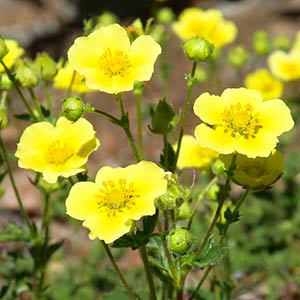Drymocallis pseudorupestris
Drymocallis fissa
cliff drymocallis, cliff woodbeauty, false rock loving cinquefoil, Rocky Mountain sticky cinquefoil
bigflower cinquefoil, leafy drymocallis or wood beauty
elongate.
short to elongate.
openly tufted to loosely spaced, (0.3–)0.6–4 dm;
base 1–3 mm diam., ± densely septate-glandular.
tufted to loosely spaced, (1.2–)1.5–3.5(–4.5) dm;
base (1.5–)2–3 mm diam., ± densely septate-glandular.
glabrate or sparsely to ± densely hairy;
basal (2–)3–16 cm, leaflet pairs (2–)3–4(–5);
terminal leaflet broadly obovate-cuneate to flabellate, 0.2–3(–4) × 0.5–3 cm, teeth single or double, 2–15 per side, apex usually rounded to truncate, sometimes obtuse;
cauline 0–2, reduced, leaflet pairs 2–3.
sparsely to moderately hairy;
basal (3–)7–19 cm, leaflet pairs (4–)5–6(–10; additional reduced leaflets sometimes interspersed);
terminal leaflet usually broadly obovate-cuneate, sometimes elliptic, (1–)1.5–3.5(–5) × (1–)1.5–3(–3.5) cm, teeth single or double, 5–13 per side, apex rounded to obtuse;
cauline 1–3, well developed, leaflet pairs 4–6(–10).
2–40-flowered, not or ± leafy, open, 1/6–3/4(–4/5) of stem, ± wide, branch angles (10–)20–40(–50)°.
5–15-flowered, leafy, congested to ± open, 1/6–1/2 of stem, narrow to wide, branch angles 15–30(–40)°.
3–20 (proximal to 40) mm, not or sparsely to moderately short-hairy, predominantly septate-glandular.
1–12 mm, short-hairy, septate-glandular.
opening widely;
epicalyx bractlets linear to elliptic, 2–6 × 1–2 mm;
sepals spreading, 4–7(–9) mm, apex acute to obtuse, apiculate;
petals overlapping or not, spreading, cream-white to pale yellow (red-tinged in var. crumiana), narrowly to broadly obovate, 4–12 × 3–11 mm, longer than sepals;
filaments 1–4 mm, anthers 0.7–1.2 mm;
styles thickened, 1–1.5 mm.
opening widely;
epicalyx bractlets linear-oblanceolate, 3–7 × 1–2 mm;
sepals spreading, 6–10 mm, apex acute to acuminate;
petals overlapping, spreading, yellow, broadly obovate, 7–11 × 5–11 mm, equal to or exceeding sepals;
filaments 1.5–4.5 mm, anthers (0.7–)1–1.4 mm;
styles thickened, 1 mm.
light brown, 1 mm.
light brown, 1 mm.
Drymocallis pseudorupestris
Drymocallis fissa
Varieties 3 (3 in the flora).
Drymocallis pseudorupestris occurs from Alberta and Washington to California and Utah, mostly in montane habitats; it is the species most often associated with rocky habitats, including talus slopes, for which its relatively elongate caudex branches are an obvious adaptation. Vestiture is dominated by abundant septate glands on stems and in the inflorescences. Except for var. pseudorupestris, which occurs only in the northeastern part of the species range, plants are relatively short, usually less than 2.5 dm. Three intergrading varieties accommodate the extremes at the northeastern and southern ends of the range.
(Discussion copyrighted by Flora of North America; reprinted with permission.)
Drymocallis fissa is distinctive in its relatively numerous leaflets (often with additional smaller ones), large flowers, and large, elongate anthers. It is most abundant in the Colorado Front Range, extending into the Medicine Bow Mountains of Wyoming. Outlying populations occur at least as far north as the Bighorn Mountains of northern Wyoming and the Black Hills of South Dakota. Tentatively included here are large-anthered populations from the eastern Uintah Mountains of Utah, though these often have fewer leaflets and smaller flowers of unknown color; they may represent a unique taxon worthy of separate recognition. Possible collections of D. fissa from New Mexico, including the type of Potentilla fissa var. major Torrey & A. Gray, are of uncertain placement in that they combine features of D. arguta, D. arizonica, and D. fissa. Reports from other states, including Montana, are probably all based on misidentified specimens.
(Discussion copyrighted by Flora of North America; reprinted with permission.)
1. Stems (1–)2–4 dm, bases (1.5–)2–3 mm diam.; basal leaves (4–)7–16 cm; terminal leaflets (1–)2–3(–4) cm, teeth usually double, (5–)8–15 per side; flowers (5–)10–40; petals 6–12 × 5–11 mm, widely overlapping; filaments 2–4 mm. | var. pseudorupestris |
1. Stems (0.3–)0.6–2.5 dm, bases 1–2(–3) mm diam.; basal leaves (2–)3–9(–15) cm; terminal leaflets 0.2–2(–4) cm, teeth single or ± double, 2–8(–12) per side; flowers 2–12(–20); petals 4–8(–9) × 3–6(–8) mm, not or ± overlapping; filaments 1–2.5(–3) mm | → 2 |
2. Basal leaves: leaflet pairs (2–)3(–4); hypanthia and sepals not bristly or bristles less than 1 mm; short hairs sparse to moderately abundant on stems and pedicels (sometimes absent); styles usually golden brown, rarely reddish. | var. saxicola |
2. Basal leaves: leaflet pairs 3–4(–5); hypanthia and sepals prominently bristly, bristles 1–1.5 mm; short hairs absent or sparse on stems and pedicels; styles usually dark red, rarely golden brown. | var. crumiana |
- Local floras:
BC,
CA,
OR
- Local Web sites:
CalFlora,
CalPhotos,
Flora NW,
PNW Herbaria
WildflowerSearch
iNaturalist (observations)
USDA Plants Database
- LBJ Wildflower Center
- SEINet
- Plants of the World Online
- Encyclopedia of Life
- Wikipedia
- Google Image Search


